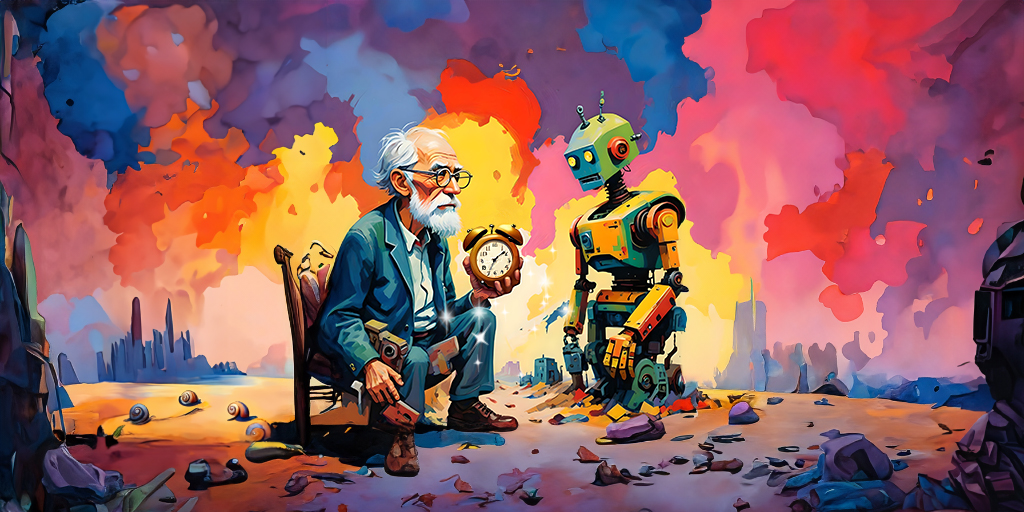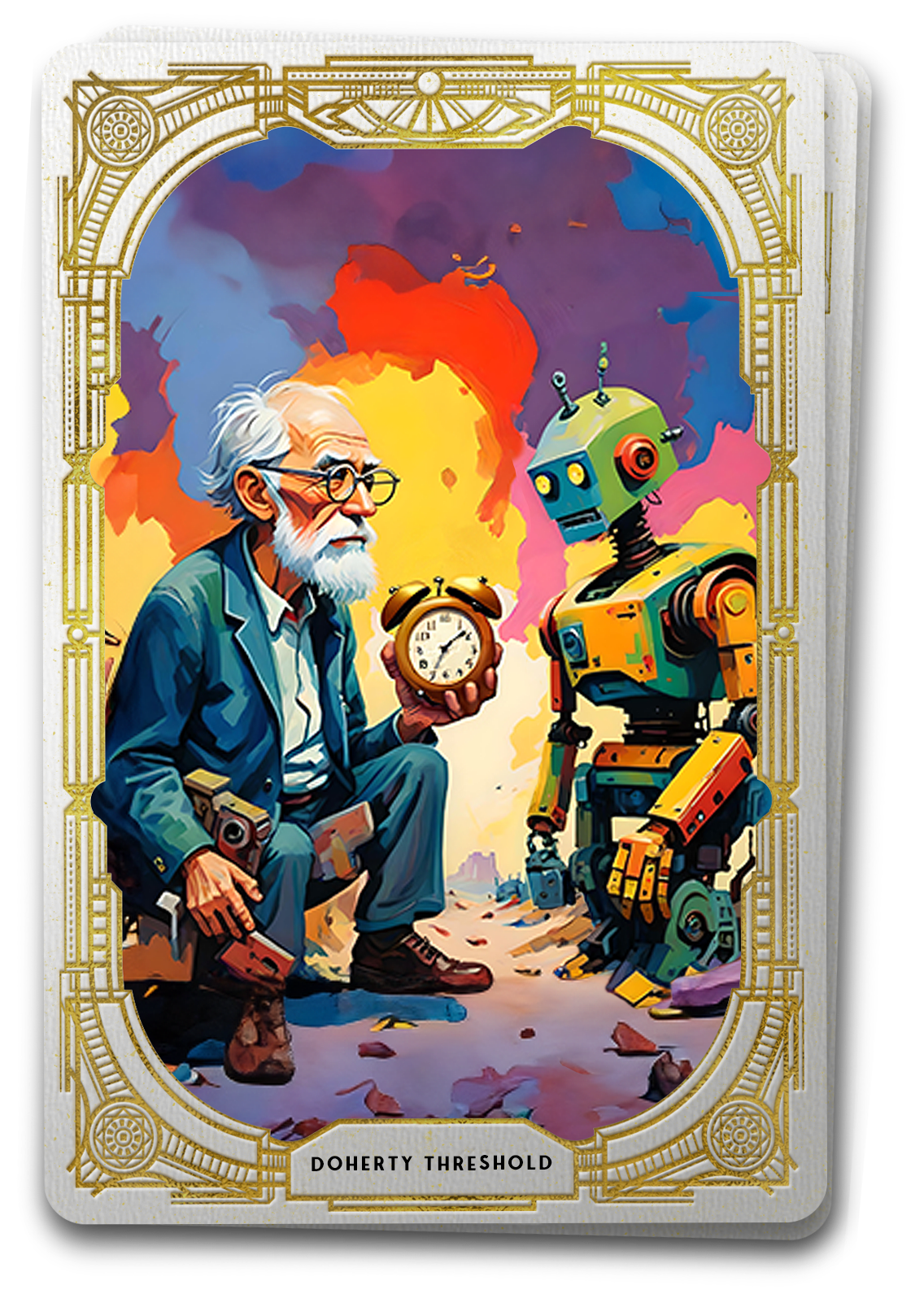
The Tarot Reveals the Doherty Threshold:
Because 401-milliseconds is just too long to wait.
Have you ever experienced the frustration of a slow and sluggish digital interaction? Picture this: every click or command met with a delay, as if trudging through molasses. We all know this feeling. Now, envision the opposite – a seamless dance where every interaction is swift and energized, never leaving you waiting. This stark contrast encapsulates the essence of the Doherty Threshold, a guiding principle in UX design that transforms sluggish digital experiences into a harmonious dance of efficiency.
Walter J. Doherty, a pioneer in the study of human-computer interaction, conducted groundbreaking research in the mid-20th century. His studies focused on understanding how users perceive and react to different response times in computing systems. Doherty’s work delved into the realm of psychology, exploring the impact of delays on user productivity and satisfaction.
In his research, Doherty aimed to identify the threshold at which interactions between users and computers become perceptually instantaneous. Through a series of experiments and observations, he found that this threshold hovered around 400 milliseconds. Beyond this point, users began to perceive delays, leading to a notable decline in satisfaction and efficiency.
Determining the Sweet Spot
The 400-millisecond mark wasn’t arbitrarily chosen; it emerged from Doherty’s meticulous observations of user behavior. Through experiments, he gauged the point at which delays became noticeable to users, affecting their perception of the interaction’s immediacy. This sweet spot became known as the Doherty Threshold (or Doherty’s Law), and is a pivotal metric in UX design, guiding designers and engineers to ensure that digital interactions remain swift and seamless.
Doherty’s experiments involved a diverse range of participants, each engaging with different computer systems under various response time conditions. The goal was to identify the threshold at which users perceived the delay in computer responses. By carefully manipulating response times and observing user reactions, Doherty was able to pinpoint the 400-millisecond mark as the critical threshold where delays became perceptually noticeable. This empirical approach laid the foundation for understanding the psychological dynamics of user-computer interactions, providing a quantitative metric that designers could leverage to enhance user experiences.
Applications in UX Design
In application, the Doherty Threshold is a beacon as much as a benchmark, illuminating the path toward optimal user experiences. Designers can leverage this principle to create interfaces where interactions are crisp and immediate, aligning with users’ expectations. By staying within the 400-millisecond threshold, designers craft digital experiences that feel responsive and effortless – promoting the ever-illusive sense of flow.
Imagine a digital experience where every click, swipe, or input is met with an immediate response, a stark departure from the lethargy of slow interactions. Designers and engineers, cognizant of Doherty’s research, focus on crafting experiences that stay within this optimal threshold. This involves fine-tuning the elements of a digital dance, ensuring users never experience the fatigue induced by delays.
Real-World Tactics to Align with the Doherty Threshold
E-Commerce Transactions
In online shopping, speed is crucial for a smooth user experience during transactions. Swift responses when users add items to their cart, proceed to checkout, or complete a purchase contribute to a satisfying and efficient digital shopping journey.
- Implement lazy loading for images and content, ensuring that only essential elements are loaded immediately, minimizing the initial page load time.
- Optimize the checkout process by reducing the number of steps, enabling users to complete transactions swiftly without encountering unnecessary delays.
Real-Time Collaboration Tools
Platforms like video conferencing and collaborative document editing heavily rely on the Doherty Threshold. Immediate response times during video calls, text input, or collaborative edits enhance the real-time nature of these tools, fostering seamless communication and collaboration.
- Prioritize real-time updates by employing efficient data synchronization techniques, ensuring that collaborative changes are reflected instantly.
- Implement predictive typing features to provide immediate feedback during text-based collaborations, aligning with users’ expectations for swift interactions.
Gaming Interfaces
The gaming industry places a premium on responsiveness. From character movements to in-game interactions, maintaining a response time within the Doherty Threshold is vital for an immersive and enjoyable gaming experience.
- Optimize graphic rendering and loading times to ensure seamless gameplay, minimizing the lag between user inputs and on-screen actions.
- Implement dynamic level loading to prioritize essential game assets, allowing users to engage with the game immediately without extended wait times.
Navigation Apps
In GPS and navigation apps, the Doherty Threshold ensures that users receive prompt directions and map updates. Swift responses when inputting destinations or adjusting routes contribute to the overall efficiency and usability of navigation experiences.
- Utilize predictive algorithms to anticipate users’ next actions, preloading relevant map data to provide immediate route adjustments.
- Optimize location tracking and map rendering to ensure that users receive real-time guidance, aligning with the dynamic nature of navigation interactions.
Form AND Function?
In contrast to the Doherty Threshold, the Aesthetic Usability Effect strikes a different facet of user perception in design. This phenomenon posits that users tend to associate visually appealing designs with higher usability, irrespective of objective effectiveness. In other words, the aesthetic appeal of a system or interface can influence users to perceive it as more efficient and user-friendly.
The Aesthetic Usability Effect underscores the significance of visual design in shaping user attitudes. A visually pleasing interface not only captures attention but also instills a positive perception of usability. This psychological interplay between aesthetics and functionality highlights the intricate nature of user experience design.
So while the Doherty Threshold and Aesthetic Usability Effect are distinct in their focus, there exists an indirect connection between them. A system that adheres to the Doherty Threshold, responding promptly to user actions, contributes to a positive user experience by maintaining engagement. When combined with a visually appealing design, as emphasized by the Aesthetic Usability Effect, the overall user satisfaction and efficiency are further heightened.
Staying within the Doherty Threshold poses challenges, especially in a digital landscape flooded with content and features. Designers and engineers must carefully balance functionality and performance to ensure that the digital dance remains seamless. Overloading a page can lead to delays, disrupting the efficient tempo that users expect.
In essence, the Doherty Threshold serves as a valuable guide, providing a quantitative metric for gauging design efficiency and user satisfaction. However, its contribution to the overall user experience should be viewed in tandem with a myriad of other factors that influence the dynamic interplay of responsiveness. Rather than a conclusive measure, the Doherty Threshold emerges as an initial reference point, sparking inspiration for designers and engineers to orchestrate the optimal tempo that harmonizes user satisfaction and productivity.





